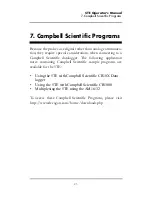
5TE Operator’s Manual
3. Theory
8
Converting Bulk EC to Pore EC
For many applications, it is advantageous to know the electri-
cal conductivity of the solution contained in the soil pores
(
σ
p
), which is a good indicator of the solute concentration in
the soil. Traditionally,
σ
p
has been obtained by extracting pore
water from the soil and measuring
σ
p
directly. As one would
expect, this is a time consuming and labor intensive process.
The 5TE measures the electrical conductivity of the bulk soil
surrounding the probes (
σ
b
). A considerable amount of
research has been conducted to determine the relationship
between
σ
b
and
σ
p
. Recent work by Hilhorst (2000), has taken
advantage of the linear relationship between the soil bulk
dielectric permittivity (
ε
b
) and
σ
p
to allow accurate conversion
from
σ
b
to
σ
p
if the
ε
b
is known. The 5TE measures
ε
b
and
σ
b
nearly simultaneously in the same soil volume. It is there-
fore well suited to this method.
The pore water conductivity can be determined from (see Hil-
horst, 2000 for derivation):
where
σ
p
is the pore water electrical conductivity (dS/m);
ε
P
is
the real portion of the dielectric permittivity of the soil pore
water (unitless);
σ
b
is the bulk electrical conductivity, (dS/m),
which is measured directly by the 5TE;
ε
b
is the real portion
of the dielectric permittivity of the bulk soil (unitless); is the
real portion of the dielectric permittivity of dry soil (unitless).
'
0
σ
'
b
b
'
p
p
b
ε
ε
σ
ε
σ
=
−
=
(1)













































